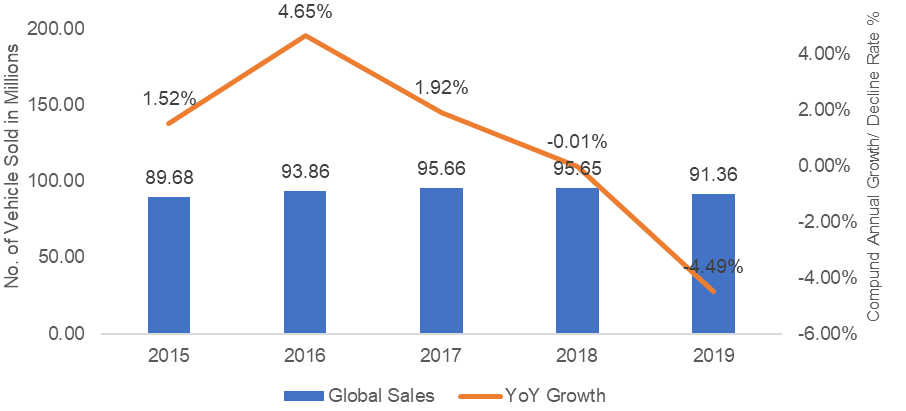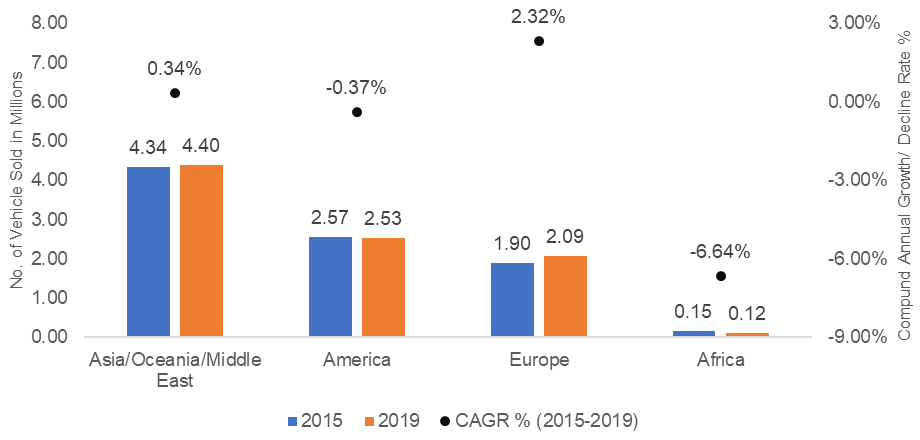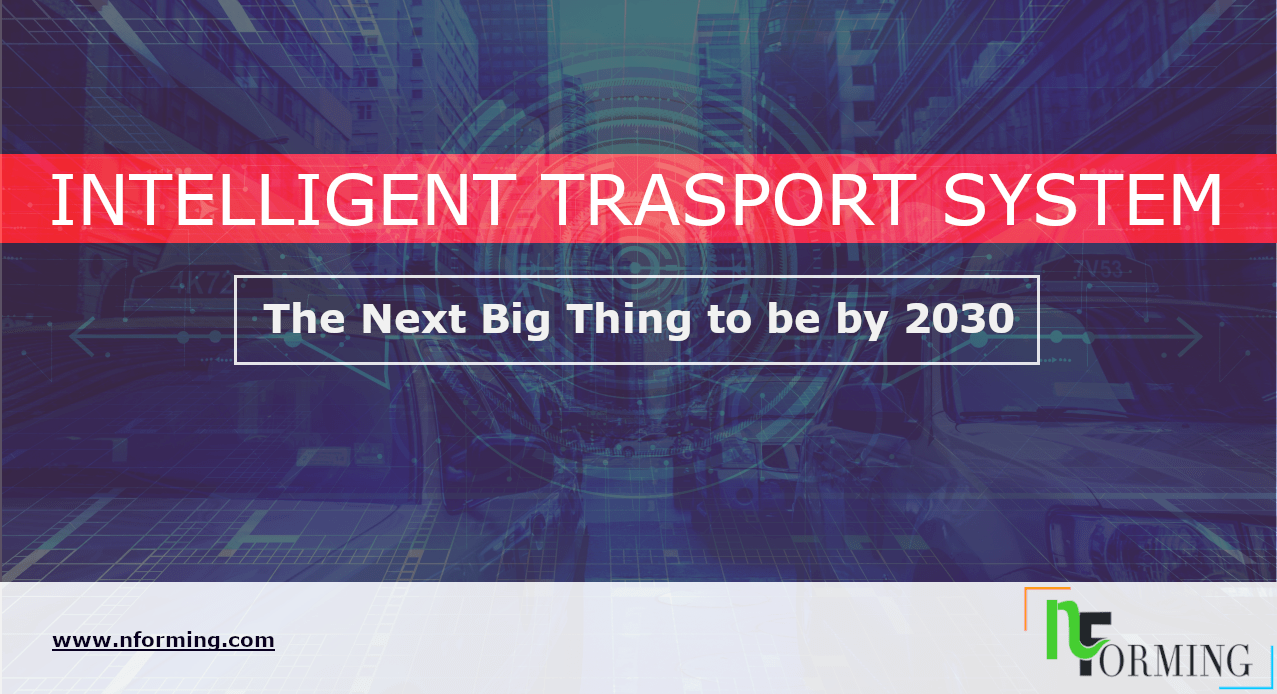Future of Intelligent Transportation System
Transportation is the life line of the any business and a country across the world. In last 5 years there has been significant increase in the need of healthy transportation that are less traffic obstruction and public safety due to growing sales of vehicles. Post mid-2021, this is further expected to affect the health of transportation system and increase the traffic obstruction and public safety in the countries that has high population density.

Source: International Organization of Motor Vehicle Manufacturers, nForming Solutions Analysis
According to annual vehicle sales of the world was grown from 89.68 million vehicles from 2015 to 95.65 million vehicles in 2018 at a CAGR 2.2%. This number has declined in 2019 as impact of low vehicle sales in America and Africa regions. However, this scenario is expected to be recovering and boosted rapidly post Covid-19 pandemic, i.e. post mid-2021. Thus, governments’ of G20 nations and other developing nations are considering the importance of the Intelligent transportation system (ITS) and expected to implement it within in next decade, throughout the country. With this ITS is expected to be the next big technology in coming decade. Also, in last five years it has emerged as the eye-catching market for many investors as its offerings focused on two main aspects of a healthy transportation that are less traffic obstruction and public safety.
Intelligent Transportation System Adoption and Application
ITS application provides services which include: Travel and traffic management, public transportation operations, electronic payment, advanced vehicle control and safety systems, and many others. ITS leads to safety transportation and improves the driving experience, it will also help to do better traffic management and use of present transportation support.

Source: International Organization of Motor Vehicle Manufacturers, nForming Solutions Analysis
Growing innovations in mobility services encouraging intelligent transportation system deployment. Many countries such as United States, United Kingdom, Australia, Canada, China, France, Germany, Italy, Japan, Republic of Korea, Russia, have already adopted and deployed different types of ITS technologies which are now expanding in other countries across the globe. Argentina, Brazil, India, Indonesia, Mexico, Saudi Arabia, South Africa, Turkey, and other developing nations are working on deploying or upgrading their ITS. For instance, in 2018, Kapsch TrafficCom, provider of intelligent transportation systems won approximately EUR 15 million project, of providing advanced traffic management systems to Argentina, Peru, and Panama.
The Intelligent Transportation System (ITS) has many advantages which is playing a vital role in the modification of the current transportation system across the world. The adoption of ITS will results significantly in both urban and rural transportation networks such as the following:
Public Safety and Environment-Friendly ITS Benefits
Due to the safe operation of Autonomous Vehicle and intelligent transportation systems there is a huge reduction in crash rates. UK safety reports say, 56% reduction in injury per month due to usage of ITS. Implementation of ITS also leads to low gas emissions which is more beneficial to the environment. Moreover, integration of the transportation system and advanced communication technology can also increase fuel saving.
Traveler and Vehicle Information Transportation is Easy
The integration of information and communication technology (ICT) with the transportation system provides transparency between public and private sources. With the help of this, the driver can easily communicate with the vehicle and likewise, a vehicle can communicate with other vehicles. Connected vehicles is one of the best applications of it.
Traffic Management Benefits
ITS application like ramp meters, TSP will reduce traffic obstruction and accident, ITS provide information about traffic jams on roads and its solution which is beneficial for public and private transportation. Study shows that the use of intelligent transportation system in London increases usage of buses by 6% and it reduces traffic by 20%.
Following are Top 3 Commonly Growing ITS Technology Segments
Electronic Toll Collection (ETC):
Electronic toll collection has a become trending application of ITS in major economies across the world. Using electronic toll collection system, now drivers can pay tolls without halting their vehicle. Thus, the electronic toll collection system is time-saving and fuel-saving; Further, it comes with the payment flexibility and reduced operating costs. Due to which, it got humongous acceptance from the from the vehicle owners. This segment was expected grow with the ~ 8% CAGR for next fives years. However, due to COVID-19 pandemic, this segment’s CAGR for next five years has been reduced to ~6.5%. Further, the revenue of this segment is expected to be impacted moderately as compared to revenues in the years 2018 and 2019.
Ramp Meter (RM):
Ramp meters are installed as traffic signals to controls the flow of vehicles .on freeways ramps that are entering expressways. This reduces freeway congestion, by controlling the amount of traffic entering from freeway by breaking the car platoons, there by supporting lowering toxic gas emission, freeway crashes, and increasing average vehicle speed. According to the US FHWA (Federal Highway Administration) Minneapolis-St. Paul, Minnesota ramp metering reduces emission by 55%. Likewise, Denver, Colorado ramp metering increases traffic speed by 50%. Due these advantages, in near future, ramp meter demand is expected to be in rising from the countries which has increasing annual vehicle sales and has high population density.
Transit Signal Priority (TSP):
It is an advanced communication system which locates TSP connected transit vehicle and manages signal time according to it. In case any emergency transit vehicle needs a stopless ride, it can ask to increase the traffic signal time if necessary. The demand of TSP is growing rapidly as there is significant increase in the number of public vehicles, which intends high possibilities of traffic jams and accidents.
A typical TSP has shown approximately 8% improvements in bus run time. According to studies, bus travel time is reduced by 16.1% in the US by using transit signal priority technology. Likewise, in other states using TSP had an 8-10% travel time reduction in transit services. Further, Chicago Transit Authority (CTA) said that 50% of Chicago region’s transit vehicle rides are requesting for transit signal priority to reduce travel time and improve transit service. Due to which various governments are now intended to choose TSP. However, this market is more likely to be disrupted by the advanced TSP solution which can improvise the bus run time by 15% to 40%.
Owing to this, major companies operating in the transportation industry are already using and also testing ITS to increase their productivity and to save on time and money. According to Accenture, 94 % of transportation leaders are exploring new technologies to attain the top place in the post-digital era of the transportation industry. This, concludes ITS can be expected to be one of the most evolving and growing technology by 2030.



